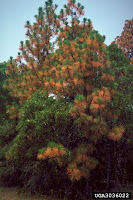Atlanta Drought is Trial by Fire for Trees

After months of little rain, trees around the Atlanta area are beginning to look a little parched.
The weakest trees are the ones that succumb to moisture stress first. Sometimes its the trees that have been damaged from soil disturbance, such as on construction sites or even on lawns that have been over-manicured. Construction sites may have compacted soil that drives out pore space in the soil. Over manicured lawns may have been over-watered in the past or been graded by machinery that destroyed fine roots in the upper strata of the soil profile.
Trees growing in regions that are already dry may be on the edge of critical moisture stress. A casual drive through south DeKalb County reveals Loblolly pines dying on the rock outcrops. These trees functioned under normal rainfall conditions, but this year has been especially hard on them. Perhaps, the stronger trees will re-populate the area.
Once called "The most massive and longest lived organisms on Earth" by the late Alex Shigo, mature trees require an enormous amount of moisture to sustain them. As the rain deficit languishes, it is the strongest and most resourceful of the trees that thrive and continue to grow through out the season. How can a tree, when grass and small plants around it die, still manage to carry on under such strenuous conditions?
Well-established trees have a root system that is astoundingly large. A tree's root system is not just a bunch of woody fingers in the soil. It is a true system, having many parts that function as whole, to deliver the tiniest of water molecules the rest of the tree. These scraps of moisture are trapped in the soil, and can only be wrenched away by a sophisticated network of microscopic organisms that are attached to the finest of root hairs. Certain types of fungi become married to tree roots, and form whole new 'drinking' organs for the tree, called michorrhizae. Without a healthy population of micorrhizae, a tree could not survive.
The entire root network, including michorrhizae and other biological relationships, extend farther than the tree's branches and can comprise 2/3 of the entire tree mass.
Comments